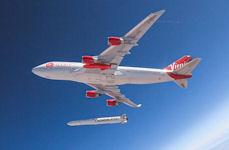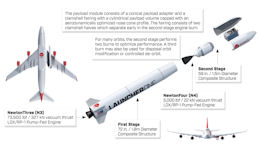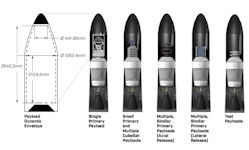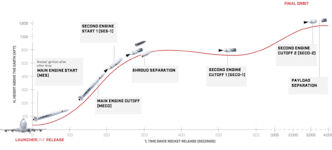VOX Space Virgin Orbit LauncherOne
 On March 2, 2017 Sir Richard Branson and Virgin Galactic announced Virgin Orbit, a new commercial space company, and the appointment of Dan Hart as the first President of the newly created company. Virgin Orbit will offer flexible, routine and low cost launch services for small satellites via the LauncherOne system. Virgin Orbit’s activities were previously conducted as a division of Virgin Galactic. Dan Hart joined Virgin Orbit after a distinguished 34 years at Boeing, where he was responsible for all of the company’s satellite programs for the US government and several allied countries. As Boeing’s Vice President of Government Satellite Systems, he led efforts in all phases of the aerospace product life cycle, from R&D through development, production and flight operations, and has supported numerous space launch missions across human spaceflight, satellite development, launch vehicle development, and missile defense.
On March 2, 2017 Sir Richard Branson and Virgin Galactic announced Virgin Orbit, a new commercial space company, and the appointment of Dan Hart as the first President of the newly created company. Virgin Orbit will offer flexible, routine and low cost launch services for small satellites via the LauncherOne system. Virgin Orbit’s activities were previously conducted as a division of Virgin Galactic. Dan Hart joined Virgin Orbit after a distinguished 34 years at Boeing, where he was responsible for all of the company’s satellite programs for the US government and several allied countries. As Boeing’s Vice President of Government Satellite Systems, he led efforts in all phases of the aerospace product life cycle, from R&D through development, production and flight operations, and has supported numerous space launch missions across human spaceflight, satellite development, launch vehicle development, and missile defense.
Virgin Orbit is headquartered in a state-of-the-art 180,000 square foot manufacturing facility in Long Beach, California, and employs a world class team of more than 200 experienced aerospace professionals. Its vehicles include the LauncherOne rocket and its 747-400 flying launch pad, dubbed Cosmic Girl. The LauncherOne service already has a substantial order book, including both commercial and government customers.
Virgin Orbit is the third company in Virgin Group’s commercial space portfolio, Galactic Ventures, led by CEO George T. Whitesides and owned by the Virgin Group and Aabar Investments PJS. The three companies are developing world-leading aerospace products and services.
Virgin Orbit, Sir Richard Branson’s small satellite launch company, builds and operates a flexible and responsive satellite launcher. LauncherOne is a dedicated launch service for commercial and government-built small satellites. LauncherOne rockets are designed and manufactured in Long Beach, California, and will be air-launched from a modified 747-400 carrier aircraft – allowing Virgin to operate from locations all over the world in order to best serve each customer’s needs. Virgin Orbit’s systems are in an advanced stage of testing, with initial orbital launches expected in 2020.
VOX Space, LLC is a US-incorporated, wholly-owned subsidiary of Virgin Orbit, LLC. VOX Space provides the national security community of the USA and allied nations with responsive, dedicated, and affordable launch services for small satellites bound for Low Earth Orbit. Headquartered in El Segundo, California, VOX Space can provide study, analysis, integration, and launch services using Virgin Orbit’s LauncherOne, while ensuring customers’ critical information is protected.
LauncherOne is a simple, expendable, launch vehicle designed to place small satellites of up to 500 kg / 1100 lbm into a wide range of Low Earth Orbits (LEO) at an affordable price. Rather than launching from the ground, LauncherOne is carried to an altitude of approximately 35,000 feet by the 747-400 carrier aircraft, Cosmic Girl. The simple design of LauncherOne increases reliability while keeping costs low. In order to balance performance with commercially-competitive pricing, LauncherOne was designed through a “clean-sheet” design process, in which all potential vehicle configurations were traded against each other (different numbers of stages, various propulsion types, etc.). Throughout LauncherOne’s design, the Virgin Orbit team actively rejected complexity, favoring a straightforward and reliable design. This avoids the common trap of incurring significant cost increases for only a marginal increase in performance.
By using a customized 747-400 aircraft as its “flying launch pad,” Virgin Orbit gains the ability to quickly transport the entire launch site to new locations around the world, launching each satellite from the optimal location. This mobile approach to launch substantially reduces the expense required for infrastructure at each launch site. In addition to the Mojave Air and Space Port — the California launch site that will be home to the company’s first orbital launch, as well as subsequent launches to high inclination orbits — other spaceports both new and established have announced that they are working to prepare themselves for future missions of LauncherOne, including the Launch and Landing Facility at the Kennedy Space Center in Florida, Spaceport Cornwall in the United Kingdom, the Taranto-Grottaglie Airport in Italy, and others.
The carrier aircraft, Cosmic Girl, takes off from the launch site with the fueled LauncherOne and payload. The plane flies out over an unpopulated flight corridor above the ocean to an altitude of 35,000 ft, and releases LauncherOne with an pitch angle of 27.5 degrees. Approximately 5 seconds later, vehicle ignition occurs and the vehicle ascends several hundred thousand feet before Stage 1 Main Engine Cutoff (MECO) occurs at approximately 3 minutes after drop. The second stage is then ignited following a short coast and carries the payload to a low parking orbit (for missions that are not direct inject), shedding the payload fairing along the way early during Stage 2’s burn.
During a coast of approximately half an orbit, passive thermal control is performed with a nominal spin rate of 0.1 RPM. Once at target apogee, a circularization burn is performed to accurately deliver the payload into its target orbit. For missions above 625 km, the second stage performs an orbit lowering burn, and final verification of correct orbit insertion occurs within 90 minutes of final payload separation.
The high-inclination launch service location is the Mojave Air & Space Port (MHV), a spaceport licensed by the FAA for commercial horizontal launch operations of reusable vehicles, such as the 747 aircraft. Additional launch sites employ similar architecture. The mobile launch capability provided to LauncherOne eliminates the need for extensive infrastructure associated with ground launch. “Clean pad” operations are entirely mobile and involve only the Cosmic Girl carrier aircraft, with LauncherOne mated underwing, and ground support trailers.
Launch operations for all spaceports are managed from Virgin Orbit’s Long Beach control room. Launch operations are additionally supported by a launch engineer on console in the 747-400 and teams on console at the headquarters facility in Long Beach. Software operated by vehicle controllers in the control room receives telemetry and commands the launch vehicle, as well as ground systems aboard the ground support trailers as needed prior to separation from the 747 aircraft.
Virgin Orbit announced 10 April 2019 that the Pacific island of Guam will become an additional launch site for the company’s LauncherOne service. With its remote location and close proximity to the equator, Guam serves as an excellent base of operations from which the company’s unique, 747-launched rocket can efficiently serve all inclinations, a boon to the rapidly expanding small satellite market. Most excitingly, the new location enables LauncherOne to deliver more than 450 kg to a 500 km equatorial orbit.
The addition of Guam to that list enhances the flexibility of Virgin Orbit’s launch operations, adding a low-latitude site with clear launch trajectories in almost all directions, giving Virgin Orbit’s customers unparalleled control over where and when their small spacecraft are deployed. Officials at US Pacific Air Forces (PACAF) issued a letter of support for Andersen Air Force Base to host launches and other exercises with LauncherOne and its dedicated carrier aircraft—a critical step en route to a first launch from the island, which could occur in as little as a year’s time. Additionally, the largest commercial airport on the island, A.B. Won Pat International Airport, has begun the process of seeking its launch site operator’s license from the Federal Aviation Authority’s (FAA) Office of Commercial Space Transportation, in order to serve as a future launch site for Virgin Orbit.
On 10 July 2019 Virgin Orbit announced that it had successfully completed a key drop test of its LauncherOne vehicle, the last major step in the development program of the company’s novel launch service. In the run-up to its first space shot, Virgin Orbit has completed a steady progression of test flights with its “flying launch pad” Cosmic Girl and LauncherOne vehicle — and today’s achievement marks the beginning of the company’s transition to its orbital test flight launch campaign.
On this flight, Virgin Orbit released a fully built, fully loaded — although inert — LauncherOne rocket from Cosmic Girl, a modified Boeing 747 that serves as the rocket’s carrier aircraft. Today’s test flight began with a takeoff from the Mojave Air and Space Port at Mojave, CA, at 8:43 A.M. Pacific; the drop itself occurred at 9:13 A.M. Pacific from an altitude of 35,000 feet over a testing range at Edwards Air Force Base. The primary purpose of the test was to monitor the few critical seconds just after release, to ensure the rocket and aircraft separate cleanly and to observe how the rocket freefalls through the air.
VOX Space, the Virgin Orbit subsidiary which provides responsive and affordable launch services for the U.S. national security community, was selected April 10, 2020 to launch three dedicated missions for the U.S. Space Force (USSF), delivering multiple spacecraft to orbit for the Department of Defense (DoD) Space Test Program-S28 (STP-S28). This launch service contract — awarded by the USSF Rocket Systems Launch Program (RSLP) Office in Albuquerque, NM — is the first task order under the Orbital Services Program-4 (OSP-4) Indefinite Delivery/Indefinite Quantity (IDIQ) contract.
OSP-4 allows the U.S. government to rapidly acquire flexible, resilient and affordable launch services, unlocking the ability to launch missions to space within 12 to 24 months of the task order award. This responsiveness is a critical capability in today’s contested space domain. The goal of the STP-S28 mission is to deploy multiple technology demonstrations to Low Earth Orbit, enabling advancements in space domain awareness and communications and informing future developments of the USSF space architecture. VOX Space and Virgin Orbit will complete the mission by conducting three separate launches with the LauncherOne system, delivering more than three dozen small satellites to orbit. The schedule for these flights is subject to change, but the first launch could occur as early as October 2021.
“We’re very eager to bring a new standard of flexibility in launch to the U.S. national security community with LauncherOne,” said VOX Space President Mandy Vaughn. “We see the STP-S28 mission as an excellent example of how cutting-edge commercial launch systems like ours can enable the U.S. Space Force to execute missions in a way that’s more tactically responsive. We look forward to working with Col. Rob Bongiovi, Lt. Col. Ryan Rose, and their excellent team at the Space and Missile System Center.”
“With the space domain more contested than ever, it’s crucial that we find ways to enable those responsible for space security to act quickly and effectively. Ultimately, we believe that affordable and responsive launch helps keep everyone safer — in part by creating a major disincentive for adversaries to work against existing satellites and space systems. LauncherOne is proving to be an impactful force for good as we work with our nation’s leaders to modernize our space systems and help keep people safe,” said Virgin Orbit CEO Dan Hart.
“We are excited to partner with VOX Space and believe the STP-S28 mission will showcase industry innovation, international partnering and provide a gateway to work with some of the newest, leading-edge entrants for emerging small launch service providers,” said Lt. Col. Ryan Rose, chief of the Small Launch and Targets Division at Kirtland Air Force Base, New Mexico.
The U.K. Space Agency (UKSA) announced November 5, 2019 that it will award £7.35 million ($9.5 million) in grant funding to Virgin Orbit U.K. Limited, the U.K. branch of Sir Richard Branson’s satellite launch company, to enable the horizontal launch of small satellites from Spaceport Cornwall at Cornwall Airport Newquay. In addition to funds and support provided by Virgin Orbit, the U.K. Space Agency grant comes as part of a broader £20 million funding package for Cornwall Airport Newquay infrastructure announced by Science Minister Chris Skidmore, which is pending final approval by Cornwall Council.
The funds will be used to develop launch operations support systems and manufacture them in the U.K. In addition, the funds will be used to conduct mission planning, and to further ready the facility for satellite launches from Cornwall, with the first spaceflight targeted for as soon as the fourth quarter of 2021, subject to U.S. and U.K. regulatory approvals. These launches will be conducted using Virgin Orbit’s innovative air launch system, LauncherOne, and could well be the first orbital launches ever conducted from the UK.
on January 28, 2020 Virgin Orbit, the California-based small satellite launch company, signed an agreement with ImageSat International (ISI), a global leader in space-based intelligence solutions, to develop an end-to-end responsive space service offering focused on national security customers. The joint turnkey service, announced at the 15th Ilan Ramon International Space Conference during Israel Space Week, would take advantage of the responsive and flexible capabilities of Virgin Orbit’s LauncherOne system to rapidly deploy ISI’s high-resolution Earth observation small satellites.
Evolving technologies and constellations will impact government satellite operators by amplifying the need to detect, assess, and respond to threats and to enhance and reinforce communications. As such, the emergence of a responsive space solution to rapidly deploy and populate small satellite constellations will enhance space resiliency, enabling deterrence.
By virtue of air-launch, LauncherOne can deliver small satellites to any inclination in Low Earth Orbit. Additionally, its modular ground support equipment (GSE) grants Virgin Orbit the flexibility to forward station or rapidly deploy the system to an array of spaceports across the world.
ISI currently operates the EROS VVHR (very, very high resolution) remote sensing constellation of satellites, which primarily enables global intelligence and national security applications. ISI is also developing new families of high-resolution Earth observation satellites — Knight, Runner, and Sprinter — which would be supported by ClearSky, its multi-satellite ground control segment.
By leveraging LauncherOne’s unique mobility alongside ISI’s data analytics solutions, the two companies can fulfill high-resolution, high-revisit requirements on short notice. This bundled service can be easily procured as turnkey solution for allied government customers.
Virgin Orbit failed 25 May 2020 in its first test launch of a new rocket carried aloft by a Boeing 747 and released over the Pacific Ocean off the coast of Southern California. The inaugural launch had appeared to be going well until moments after the rocket was dropped from beneath the left wing of the jumbo jet dubbed Cosmic Girl. “We’ve confirmed a clean release from the aircraft. However, the mission terminated shortly into the flight. Cosmic Girl and our flight crew are safe and returning to base,” Virgin Orbit said in its official commentary on the launch. There was no immediate word on what went wrong with the rocket, which carried a test satellite.
|
NEWSLETTER
|
| Join the GlobalSecurity.org mailing list |
|
|
|








